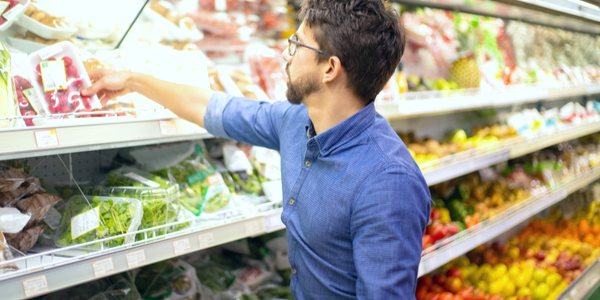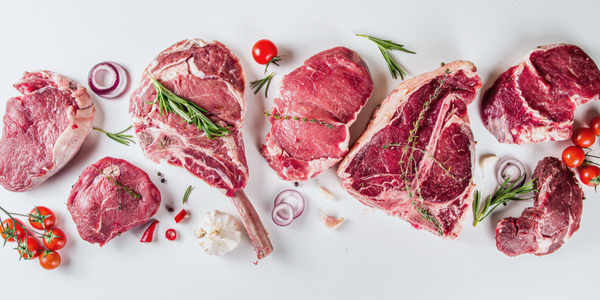
For those diagnosed with celiac disease or gluten intolerance, eliminating gluten-containing foods is the only known treatment.
Without proper management, adults and children with celiac disease are at risk of a number of health conditions. Serious and long-term consequences include nutrient deficiencies, osteoporosis, and anemia. Children can have developmental delays and stunted growth.
But what are gluten foods to begin with and what foods are high in gluten? Learn the basics of gluten intolerance, foods to avoid, and find a simple solution to a gluten-free diet!
High Gluten Foods
Gluten is a protein found in a variety of grains. It helps food maintain their shape and acts as the glue to hold food together. When it comes to eating gluten-free, whole grains are mostly of concern.
According to the Celiac Disease Foundation, gluten-containing grains and their derivatives include:
• Wheat*
• Varieties and derivatives of wheat, including durum, einkorn, emmer, farina, farro, graham, semolina, spelt, and wheat berries*
• Rye
• Barley
• Triticale
• Malt in various forms, such as malted barley flour, extract, and syrup
• Brewer's yeast
• Wheat starch*
*While a wheat allergy is vastly different from celiac disease, this list can also apply.
In addition to avoiding these gluten-containing grains in their whole form, steer clear of their byproducts. This often includes processed foods prepared with wheat flour and other gluten-containing ingredients, including:
• Pastas and noodles: ravioli, ramen, couscous, udon, soba egg noodles
• Breads and tortillas: croissants, naan, bagels, flatbreads, cornbread, flour tortillas, breadcrumbs, rolls
• Crackers and chips: pretzels, graham crackers, Wheat Thins, multi-grained chips
• Baked goods and pastries: donuts, cakes, cookies, pie crusts, brownies
• Cereals: granolas, breakfast cereals, oats*
• Breakfast foods: pancakes and waffle mixes, French toast, biscuits
• Sauces and gravies: soy sauce, cream sauces made with a roux
• Soups: especially cream-based soups that use flour as a thickening agent
• Salad dressings and marinades: especially if including malt vinegar
• Granola and protein bars
• Meats: meat substitutes, lunch, and pre-seasoned meats
• Malted beverages: beers, ales, lagers, malt milkshakes
• Candy and candy bars
*Though oats are generally considered safe, they are often manufactured in food plants that also process wheat. This can subsequently increase the risk of cross-contamination (more on this below).
Aside from the recognizable sources of gluten, sauces, dressings, marinades, and other products may contain hidden gluten. Cosmetics and medications are also unlikely culprits.
Naturally Gluten-Free Foods
So, what can people with celiac disease or senstivity eat then? There's plenty! Look no further than this complete list of gluten-free food and snack options.
Gluten-Free Grains - Rice Options
All plain rice is gluten-free including white, brown, wild, long-grained, and basmati rice. However, most flavored rice and vinegar-based sushi rice contain gluten ingredients.
Gluten-Free Grains - Oats
Again, though oats are naturally gluten-free, they are commonly manufactured with the same equipment as gluten-containing cereals. Prevent cross-contamination risk by identifying a "gluten-free" label on the product.
Gluten-Free Grains – Corn
This whole grain in all forms is absent of gluten - cornmeal, corn flour, corn starch, etc. It is most important to be mindful of the ingredients added with corn.
Gluten-Free Grains – Other Selections
There are a number of whole grains that are naturally free of gluten, including amaranth, buckwheat, and millet.
Along with including more gluten-free grains, the food sources below are considered to be safe on a gluten-free diet. What's more, they are nutritious components of a well-balanced diet.
Gluten-Free Fruits & Vegetables
Fresh fruits and veggies are encouraged not only for overall health but on a gluten-free diet. So enjoy all the nutritious, colorful produce the market has to offer like apples, asparagus, berries, broccoli, cauliflower, tomatoes, and zucchini.
Be cautious of packaged veggies and fruits prepared with a sauce or other ingredients, as gluten may be present.
Beans and Legumes
Beans, lentils, peanuts, and other legumes are free of gluten while offering plant-based protein and fiber.
Meat and Poultry
Chicken, turkey, lean beef, and eggs are excellent options on the gluten-free diet list. They are rich protein sources to support countless health benefits like weight loss, muscle growth, and a strong metabolism.
Breaded chicken breasts and similar products may contain gluten, so be sure to look at the label in detail.
Fish and Seafood
From tuna to shrimp, fish and seafood varieties are naturally free of gluten. They are also a rich source of protein, healthy fat, and other beneficial nutrients.
Like meat and poultry products, be cautious of battered and breaded fish that may contain gluten.
Nuts and Seeds
Walnuts, pecans, flax seeds, and other nut and seed assortments are free of gluten.
Additionally, nut meals make a great alternative to gluten-based flours.
Safe Dairy Products
Milk, butter, and real cheese are free of gluten. Flavored dairy products, including yogurts and ice creams, should be yielded with caution.
Soy
Soy and soybean products are naturally gluten-free and an excellent source of protein, iron, and calcium.
Tapioca
Produced from the cassava root, tapioca is actually not a grain at all and coined as naturally gluten-free. But like oats, tapioca has a high risk of cross-contamination so should be used with caution.
Other Considerations When Creating a Gluten Food List
In addition to knowing high gluten foods and those without the protein, consider these factors when adopting a gluten-free diet.
Beware of Cross-Contamination
Like oats, naturally gluten-free foods can become contaminated through cross-contact. This often occurs when sharing utensils, cooking and storing environments.
Common places where cross-contact can occur include toasters, fryers, and cutting boards. Other foods that can be contaminated easily include foods include pizza, French fries, and baked goods.
Think Outside of High Gluten Foods
Numerous non-food sources may contain gluten, including nutritional and herbal supplements, medications, and cosmetics. Always consult with a healthcare professional and read labels before taking any sort of questionable product.
Ultimately, verify whether or not gluten is present by taking advantage of food product labels. Also, ask the chefs or servers about gluten-free options when eating out. If skeptical of a food, skip out on it to lower the risk of gluten intake.
A registered dietitian can also help create an individualized plan to ensure nutritional needs are being met while eliminating gluten.
Enjoy a Gluten-Free Diet Made Simple and Delicious
With gluten widespread in the food supply, going gluten-free requires attention to food labels and cross-contamination. Successful elimination in itself may come with substantial pressure. Add on the desire for weight loss whilst ensuring adequate nutrient intake, stress may only be exacerbated.
Effectively following a nutritious, gluten-free diet will come easy and naturally with bistroMD's Gluten-Free Program. By entrusting in bistroMD, members receive a custom program sure to be devoid of gluten. All meals are tested to the Food and Drug Administration gluten-free standard, or 20 parts per million (ppm) or less.
Gluten-free options are also far from limited! Kickstart the day with a breakfast Tostado, enjoy cinnamon toast pretzels as a gluten-free snack, cap the day with California-style beef sliders, and so much more!
Really, bistroMD takes care of all the work, including grocery shopping, cooking, and cleaning! Gluten-free meals are also created with fresh and all-natural ingredients that arrive directly at doorsteps. Members can also consult with dietitians and receive one-on-one support.
Recapping the Gluten Food List
Overall, high gluten foods are those prepared with wheat, barley, and rye. However, other foods and products can be hidden sources of gluten.
Despite the widespread of gluten in the food supply, countless naturally gluten-free foods are also available to enjoy. It is important, however, to balance the diet appropriately instead of falling into the health halo of common gluten-free products - think cookies, chips, etc.
Working with a dietitian or another nutrition expert is helpful for creating a healthy gluten-free diet list. A meal delivery service like bistroMD can also ease the stress of creating a safe and balanced gluten-free diet.






